Past
The City of Chicago: "Pre-Maxwell"
The city of Chicago in 1850 was mainly a trading post. People saw
the potential of the city, and a set of railroad tracks were laid through
the city. 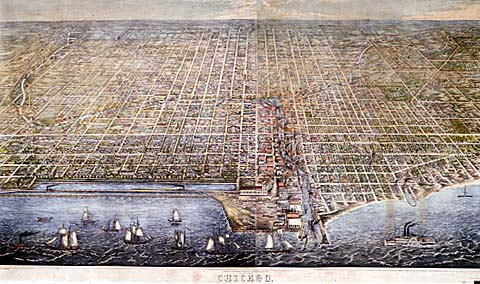 People
began to move to the city and the population quickly tripled from 30,000
to 109,000. The city began to industrialize with the production of
many new companies looking for workers. The city was growing quickly
which meant they had to be building quickly. They had easy access
to the forests of Wisconsin and Minnesota. The new buildings were
virtually all made out of wood. That help the city grow quickly,
but it also brought about some major problems.
People
began to move to the city and the population quickly tripled from 30,000
to 109,000. The city began to industrialize with the production of
many new companies looking for workers. The city was growing quickly
which meant they had to be building quickly. They had easy access
to the forests of Wisconsin and Minnesota. The new buildings were
virtually all made out of wood. That help the city grow quickly,
but it also brought about some major problems.
There were many different types of immigrants pouring into the city.
For the most part, they were Irish, German, and Jewish. These different
ethnic groups stuck together as they tried to get a foothold in this new
territory they called home. One of the major issues in Chicago, in
the late nineteenth century, was that of prohibition. The Protestants
and Americans were for it, while there was strong opposition from the Germans
and the Irish. This brought about violence and gangs bootlegging
liquor. While people were busy arguing about where and when they
could drink alcohol, they overlooked the fact that they were living in
a fire hazard. Their city was built entirely out of wood. There
was nowhere near enough fire fighters to compete with the city's population.
That brought about the dramatic event of the Great Fire of Chicago in 1871.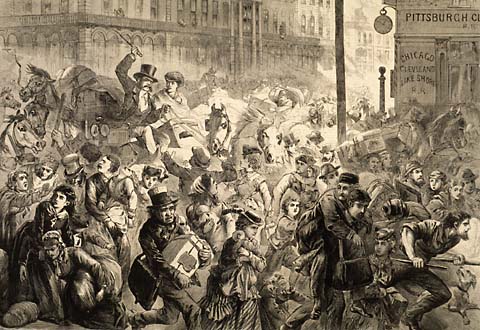
The Great Chicago Fire left many of the people in confusion, especially
the new immigrants. The new immigrants had just got settled, and
were left homeless after the blaze in the end of 1871. They used
just about all they had to rebuild their houses and the government had
to raise taxes in order to help rebuild the city. The people had
to pull together to survive these trying times. The fire brought
in many young men looking for work in the construction companies, which
was the most lucrative business at the time. The saloons and gambling
houses flourished where these new workers lived. This once again
heated up the topic of prohibition. The governor was forced to take
action, and he passed a bill that raised the license tax when opening a
saloon.
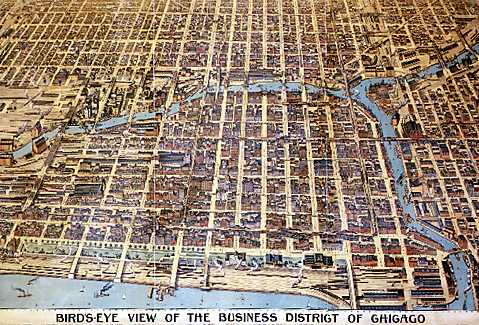 A bit of a financial depression hit when a New York City Bank failed.
This little depression was nationwide, but it hit Chicago especially hard
because they had been in a rebuilding spree. This depression slowed
the rebuilding and caused the depression to hit the citizens of Chicago.
Many of the immigrants were just scrapping by as it was. This made
it a little worse and forced them to pull together even closer as an ethnicity.
The birth of the market came about by a group of Bohemian and German immigrants.
By 1885, a large number of Jewish immigrants began settling near S. Halsted
Street and Maxwell Street. Eventually, the Jewish community dominated,
in numbers, over the other immigrants. The market had become, not
only a place to shop, but also a place to socialize, as many were from
the same ethnic culture.
A bit of a financial depression hit when a New York City Bank failed.
This little depression was nationwide, but it hit Chicago especially hard
because they had been in a rebuilding spree. This depression slowed
the rebuilding and caused the depression to hit the citizens of Chicago.
Many of the immigrants were just scrapping by as it was. This made
it a little worse and forced them to pull together even closer as an ethnicity.
The birth of the market came about by a group of Bohemian and German immigrants.
By 1885, a large number of Jewish immigrants began settling near S. Halsted
Street and Maxwell Street. Eventually, the Jewish community dominated,
in numbers, over the other immigrants. The market had become, not
only a place to shop, but also a place to socialize, as many were from
the same ethnic culture.
History of Maxwell
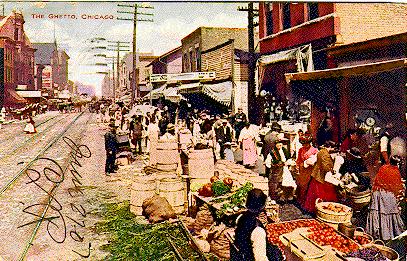 Located just outside the Loop, the South side was a perfect area, as it
was the "port" where many immigrant and ethnic groups were settling in.
The open air market was a place targeted for people at the economic bottom
to shop freely. It benefited both the shopper and vendor. For
the consumer, it was a cheaper way for obtaining goods and services because
they were inexpensive. For vendors, it was a low cost way to start
an enterprise, exchange information, build a reputation for trust, and
earn income. Such a market helped small farmers, required little
infrastructure, recycled goods and materials, and contributed to making
the world a safer and saner place.
Located just outside the Loop, the South side was a perfect area, as it
was the "port" where many immigrant and ethnic groups were settling in.
The open air market was a place targeted for people at the economic bottom
to shop freely. It benefited both the shopper and vendor. For
the consumer, it was a cheaper way for obtaining goods and services because
they were inexpensive. For vendors, it was a low cost way to start
an enterprise, exchange information, build a reputation for trust, and
earn income. Such a market helped small farmers, required little
infrastructure, recycled goods and materials, and contributed to making
the world a safer and saner place.
Until the mid-1940's, the market was predominately Jewish. Around
this time, blues musicians from New Orleans began migrating to areas such
as Bronzeville. This began attracting African Americans and others
from all around Chicago to the market.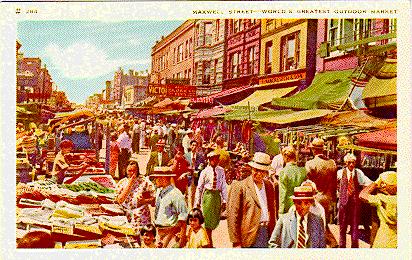
Meanwhile, after World War II, the Jewish community felt more comfortable
mixing with other ethnic groups. As a result, the Jewish, who once
dominated the Market, moved away from it, and began shopping in the downtown
area, where many of the kosher delicatessens moved as well. With
the Market changing, many Jews began moving to areas such as Skokie and
Rogers Park. Those who lived by Maxwell eventually moved south to
the Hyde Park neighborhood.
With the changes in population, faces around the neighborhood were also
changing. What once used to be a Jewish synagogue became the Gethsemane
Baptist Church. Just north of this location was St. Francis of Assissi,
originally a German Catholic Church that, in time, became mostly Hispanic.
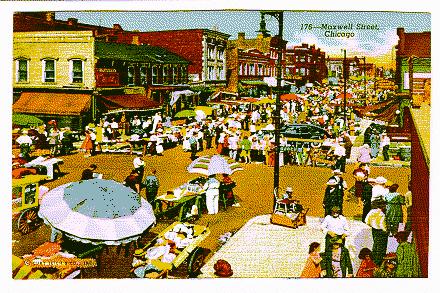 While the Maxwell Street community allowed more diversity, it became home
to many accomplished crasftsmen, artists, and musicians. People from
all around town were coming to this flea-market, as it offered, basically,
anything you wanted at a price one could afford. Best of all, you
could bargain for a cheaper price.
While the Maxwell Street community allowed more diversity, it became home
to many accomplished crasftsmen, artists, and musicians. People from
all around town were coming to this flea-market, as it offered, basically,
anything you wanted at a price one could afford. Best of all, you
could bargain for a cheaper price.
The food offered at the market changed with the changes in ethnic cultures.
Serving kosher meals soon became a fad. Small vendors began moving
in selling such items as tacos, gorditas, barbecue ribs, and pork chops,
to name a few.
As great as the market was, it also had a dark side. Liquor had always
been available, even during the Prohibition era. Other illegal activities
also sneaked along, such as prostitution and gambling. With such
events going on, it soon became an eyesore for the city. This eventually
led to the perception of the Market in a negative perspective to many across
the city of Chicago.
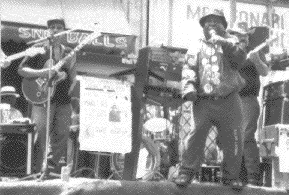 With the migration of blacks into the neighborhood, along came the introduction
of the blues. Many legendary performers got their start on Maxwell
Street. Muddy Waters, Earl Hooker, Little Walter, Howlin' Wolf, Elmore
James, Jimmy Rogers are just a few who began here. Over the years,
several local bands have formed here, such as Piano C. Red, Daddy Stovepipe,
and Moody Jones' Maxwell Street Band. Some of these local bands can
still be found performing at the New Maxwell Street Market.
With the migration of blacks into the neighborhood, along came the introduction
of the blues. Many legendary performers got their start on Maxwell
Street. Muddy Waters, Earl Hooker, Little Walter, Howlin' Wolf, Elmore
James, Jimmy Rogers are just a few who began here. Over the years,
several local bands have formed here, such as Piano C. Red, Daddy Stovepipe,
and Moody Jones' Maxwell Street Band. Some of these local bands can
still be found performing at the New Maxwell Street Market.
Present
Future
Creators
Resources
 People
began to move to the city and the population quickly tripled from 30,000
to 109,000. The city began to industrialize with the production of
many new companies looking for workers. The city was growing quickly
which meant they had to be building quickly. They had easy access
to the forests of Wisconsin and Minnesota. The new buildings were
virtually all made out of wood. That help the city grow quickly,
but it also brought about some major problems.
People
began to move to the city and the population quickly tripled from 30,000
to 109,000. The city began to industrialize with the production of
many new companies looking for workers. The city was growing quickly
which meant they had to be building quickly. They had easy access
to the forests of Wisconsin and Minnesota. The new buildings were
virtually all made out of wood. That help the city grow quickly,
but it also brought about some major problems.

 A bit of a financial depression hit when a New York City Bank failed.
This little depression was nationwide, but it hit Chicago especially hard
because they had been in a rebuilding spree. This depression slowed
the rebuilding and caused the depression to hit the citizens of Chicago.
Many of the immigrants were just scrapping by as it was. This made
it a little worse and forced them to pull together even closer as an ethnicity.
The birth of the market came about by a group of Bohemian and German immigrants.
By 1885, a large number of Jewish immigrants began settling near S. Halsted
Street and Maxwell Street. Eventually, the Jewish community dominated,
in numbers, over the other immigrants. The market had become, not
only a place to shop, but also a place to socialize, as many were from
the same ethnic culture.
A bit of a financial depression hit when a New York City Bank failed.
This little depression was nationwide, but it hit Chicago especially hard
because they had been in a rebuilding spree. This depression slowed
the rebuilding and caused the depression to hit the citizens of Chicago.
Many of the immigrants were just scrapping by as it was. This made
it a little worse and forced them to pull together even closer as an ethnicity.
The birth of the market came about by a group of Bohemian and German immigrants.
By 1885, a large number of Jewish immigrants began settling near S. Halsted
Street and Maxwell Street. Eventually, the Jewish community dominated,
in numbers, over the other immigrants. The market had become, not
only a place to shop, but also a place to socialize, as many were from
the same ethnic culture.
 Located just outside the Loop, the South side was a perfect area, as it
was the "port" where many immigrant and ethnic groups were settling in.
The open air market was a place targeted for people at the economic bottom
to shop freely. It benefited both the shopper and vendor. For
the consumer, it was a cheaper way for obtaining goods and services because
they were inexpensive. For vendors, it was a low cost way to start
an enterprise, exchange information, build a reputation for trust, and
earn income. Such a market helped small farmers, required little
infrastructure, recycled goods and materials, and contributed to making
the world a safer and saner place.
Located just outside the Loop, the South side was a perfect area, as it
was the "port" where many immigrant and ethnic groups were settling in.
The open air market was a place targeted for people at the economic bottom
to shop freely. It benefited both the shopper and vendor. For
the consumer, it was a cheaper way for obtaining goods and services because
they were inexpensive. For vendors, it was a low cost way to start
an enterprise, exchange information, build a reputation for trust, and
earn income. Such a market helped small farmers, required little
infrastructure, recycled goods and materials, and contributed to making
the world a safer and saner place.

 While the Maxwell Street community allowed more diversity, it became home
to many accomplished crasftsmen, artists, and musicians. People from
all around town were coming to this flea-market, as it offered, basically,
anything you wanted at a price one could afford. Best of all, you
could bargain for a cheaper price.
While the Maxwell Street community allowed more diversity, it became home
to many accomplished crasftsmen, artists, and musicians. People from
all around town were coming to this flea-market, as it offered, basically,
anything you wanted at a price one could afford. Best of all, you
could bargain for a cheaper price.
 With the migration of blacks into the neighborhood, along came the introduction
of the blues. Many legendary performers got their start on Maxwell
Street. Muddy Waters, Earl Hooker, Little Walter, Howlin' Wolf, Elmore
James, Jimmy Rogers are just a few who began here. Over the years,
several local bands have formed here, such as Piano C. Red, Daddy Stovepipe,
and Moody Jones' Maxwell Street Band. Some of these local bands can
still be found performing at the New Maxwell Street Market.
With the migration of blacks into the neighborhood, along came the introduction
of the blues. Many legendary performers got their start on Maxwell
Street. Muddy Waters, Earl Hooker, Little Walter, Howlin' Wolf, Elmore
James, Jimmy Rogers are just a few who began here. Over the years,
several local bands have formed here, such as Piano C. Red, Daddy Stovepipe,
and Moody Jones' Maxwell Street Band. Some of these local bands can
still be found performing at the New Maxwell Street Market.